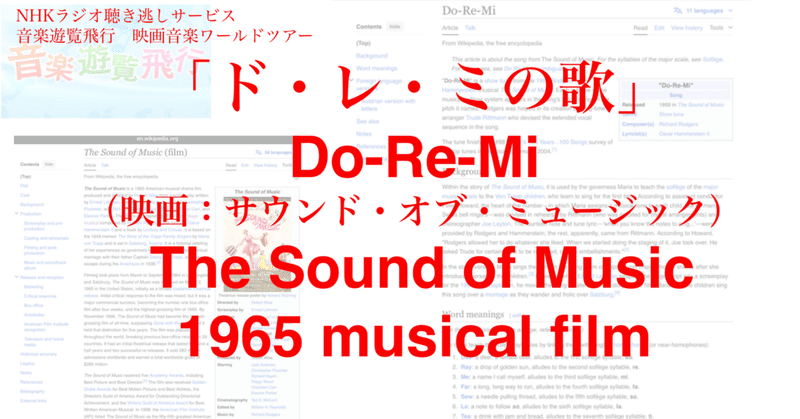
ラジオ生活:音楽遊覧飛行 映画音楽ワールドツアー 「ド・レ・ミの歌」(映画:サウンド・オブ・ミュージック)
聞き逃しサービス2024/03/22 放送
音楽遊覧飛行
映画音楽ワールドツアー
リクエスト特集
〜
〜
「ド・レ・ミの歌」( Do-Re-Mi )
(映画:サウンド・オブ・ミュージック[The Sound of Music])
オリジナルサウンドトラックから
(5分33秒)
〜
開始より06分30秒頃 (終了より33分30秒前頃)
〜
〜
配信終了2024/03/29 10:30
(すでに配信終了してます。)
番組情報
Google検索 URL> https://www.google.co.jp/search?tbm=vid&hl=ja&source=hp&biw=&bih=&q=Do-Re-Mi+Sound_of_Music
Bing検索> https://www.bing.com/videos/search?q=Do-Re-Mi+Sound_of_Music
ド・レ・ミの歌
Wikipedia EN(英語版) URL> https://en.wikipedia.org/wiki/Do-Re-Mi
〜
"Do-Re-Mi" is a show tune from the 1959 Rodgers and Hammerstein musical The Sound of Music. Each syllable of the musical solfège system appears in the song's lyrics, sung on the pitch it names. Rodgers was helped in its creation by long-time arranger Trude Rittmann who devised the extended vocal sequence in the song.
The tune finished at #88 in AFI's 100 Years...100 Songs survey of the top tunes in American cinema in 2004.
…
【】Background
Within the story of The Sound of Music, it is used by the governess Maria to teach the solfège of the major musical scale to the Von Trapp children, who learn to sing for the first time. According to assistant conductor Peter Howard, the heart of the number—in which Maria assigns a musical tone to each child, like so many Swiss bell ringers—was devised in rehearsal by Rittmann (who was credited for choral arrangements) and choreographer Joe Layton. The fourteen note and tune lyric—'when you know the notes to sing...'—were provided by Rodgers and Hammerstein; the rest, apparently, came from Rittmann. According to Howard, "Rodgers allowed her to do whatever she liked. When we started doing the staging of it, Joe took over. He asked Trude for certain parts to be repeated, certain embellishments."[2]
In the stage version, Maria sings the song in the living room of Captain von Trapp's house shortly after she introduces herself to the children.[3] However, when Ernest Lehman adapted the stage script into a screenplay for the 1965 film adaptation, he moved the song to later on in the story. In the film, Maria and the children sing this song over a montage as they wander and frolic over Salzburg.
…
【】Word meanings
(For the actual origins of the solfège, refer to Solfège.)
The lyrics teach the solfège syllables by linking them with English homophones (or near-homophones):
1. Doe: a deer, a female deer, alludes to the first solfège syllable, do.
2. Ray: a drop of golden sun, alludes to the second solfège syllable, re.
3. Me: a name I call myself, alludes to the third solfège syllable, mi.
4. Far: a long, long way to run, alludes to the fourth solfège syllable, fa.
5. Sew: a needle pulling thread, alludes to the fifth solfège syllable, so.
6. La: a note to follow so, alludes to the sixth solfège syllable, la.
7. Tea: a drink with jam and bread, alludes to the seventh solfège syllable, ti.
As the song concludes, "When you know the notes to sing, you can sing most anything."
Author Douglas Adams noted in his article "Unfinished Business of the Century" that, while each line of the lyric takes the name of a note from the solfège scale, and gives its meaning, "La, a note to follow So..." does not fit that pattern and should be considered a placeholder. Adams humorously imagined that Oscar Hammerstein just wrote "a note to follow So" and thought he would have another look at it later, but could not come up with anything better.
…
〜[Excerpted from above Wikipedia.]
〜[上記wikipediaの日本語翻訳は次の通り。翻訳にはアプリ「DeepL」を使用。]
「ドレミ」は、1959年のロジャース&ハマースタイン・ミュージカル『サウンド・オブ・ミュージック』の劇中歌。 ソルフェージュの各音節が歌詞に登場し、その音高で歌われる。 ロジャースは、長年のアレンジャーであるトゥルーデ・リットマン(Trude Rittmann)にこの曲の創作を助けられた。
この曲は、2004年にAFIが行ったアメリカ映画におけるトップチューンの調査「100 Years...100 Songs」で88位にランクインした。
…
【】背景
『サウンド・オブ・ミュージック』のストーリーの中では、家庭教師のマリアが、初めて歌を習うフォン・トラップ家の子供たちに長音階のソルフェージュを教えるために使う。 副指揮者のピーター・ハワードによれば、マリアがスイスの鐘つきたちのように子どもたち一人ひとりに音色を割り当てるこのナンバーの核心は、リハーサルでリットマン(合唱編曲を担当)と振付師のジョー・レイトンによって考案された。 14の音符と曲の歌詞-「歌うべき音符がわかったら...」-はロジャースとハマースタインが提供したもので、残りはリットマンが作ったらしい。 ハワードによれば、「ロジャースは彼女に好きなことをさせていた。 私たちが演出を始めたとき、ジョーが引き継いだ。 彼はトゥルーデに、ある部分を繰り返し、ある装飾をするように頼んだ」。
舞台版では、マリアは子供たちに自己紹介した直後、フォン・トラップ大尉の家の居間でこの歌を歌うが[3]、アーネスト・リーマンが1965年の映画化のために舞台の脚本を脚本化した際、彼はこの歌を物語の後半に移動させた。 映画では、マリアと子供たちがザルツブルクの町を歩き回り、戯れるモンタージュの中でこの歌を歌う。
…
【】単語の意味
(ソルフェージュの実際の起源については、『ソルフェージュ』を参照)。
歌詞は、ソルフェージュの音節を英語の同音異義語(または同音異義語に近いもの)と結びつけて教えている:
1. Doe: 鹿、メスの鹿、ソルフェージュの最初の音節doを暗示する。
2. Ray: 黄金の太陽の一滴は、ソルフェージュの第2音節reを暗示している。
3. ミー:私が自分自身を呼ぶ名前、3番目のソルフェージュ音節、ミを暗示している。
4. Far:長い長い道のりを走る、ソルフェージュ第4音節faを暗示している。
5. 縫う:糸を引っ張る針、ソルフェージュの第5音節soを暗示している。
6. ラ:ソに続く音符、第6ソルフェージュ音節ラを暗示。
7. 紅茶:ジャムやパンの入った飲み物で、ソルフェージュの第7音節tiを暗示している。
この歌の最後にあるように、"歌うべき音を知っていれば、たいていのことは歌える"。
作家のダグラス・アダムスは、自身の記事『世紀の未完成事業』の中で、歌詞の各行がソルフェージュ音階の音名を取り、その意味を示しているのに対し、「La, a note to follow So...」はそのパターンに当てはまらず、プレースホルダーと考えるべきだと指摘している。 アダムスは、オスカー・ハマースタインがただ "a note to follow So "と書いて、後でもう一度見てみようと思ったが、それ以上のものが思いつかなかったのだろうとユーモラスに想像した。
…
〜
映画「サウンド・オブ・ミュージック」
The Sound of Music (film)
Wikipedia EN(英語版) URL> https://en.wikipedia.org/wiki/The_Sound_of_Music_(film)
〜
The Sound of Music is a 1965 American musical drama film produced and directed by Robert Wise from a screenplay written by Ernest Lehman, and starring Julie Andrews and Christopher Plummer, with Richard Haydn, Peggy Wood, Charmian Carr, and Eleanor Parker. The film is an adaptation of the 1959 stage musical composed by Richard Rodgers, with lyrics by Oscar Hammerstein II and a book by Lindsay and Crouse. It is based on the 1949 memoir The Story of the Trapp Family Singers by Maria von Trapp and is set in Salzburg, Austria. It is a fictional retelling of her experiences as governess to seven children, her eventual marriage with their father Captain Georg von Trapp, and their escape during the Anschluss in 1938.
…
〜[Excerpted from above Wikipedia.]
〜[上記wikipediaの日本語翻訳は次の通り。翻訳にはアプリ「DeepL」を使用。]
『サウンド・オブ・ミュージック』は、アーネスト・リーマンの脚本をロバート・ワイズが製作・監督し、ジュリー・アンドリュースとクリストファー・プラマーが主演、リチャード・ハイドン、ペギー・ウッド、チャーミアン・カー、エレノア・パーカーらが共演した1965年のアメリカのミュージカル・ドラマ映画である。 この映画は、リチャード・ロジャース作曲、オスカー・ハマースタイン2世作詞、リンゼイとクラウス脚本による1959年の舞台ミュージカルの映画化である。 マリア・フォン・トラップによる1949年の回顧録『The Story of the Trapp Family Singers』に基づいており、オーストリアのザルツブルクが舞台。 ジュリー・アンドリューが7人の子供たちの家庭教師をしていたこと、やがて子供たちの父親であるゲオルク・フォン・トラップ大尉と結婚したこと、そして1938年のドイツ国交断絶の際の逃避行をフィクションとして描いている。
…
〜
この記事が気に入ったらサポートをしてみませんか?
